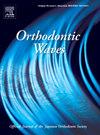两种类型上颌嵌塞手术治疗因髁突变形导致的骨骼II类开咬患者后颞下颌关节稳定性的初步研究
IF 0.5
Q4 DENTISTRY, ORAL SURGERY & MEDICINE
引用次数: 1
摘要
摘要目的:本研究的目的是评估两种类型的下颌自转概念(MAC)手术的效果,该手术使用上颌嵌塞结合直锁微型钢板(SLM)技术治疗骨骼II类开放性咬合患者的髁突。材料和方法:本研究包括14例女性开放性咬合下颌二级后缩患者。根据MAC手术的类型将患者分为两组:一组仅接受上颌嵌塞治疗的受试者(MAC-1组)和一组接受上颌嵌塞加下颌截骨治疗的受检者(MAC-2组)。制作了3D打印CAD/CAM晶片。SLM技术是为了在手术过程中稳定垂直的上下颌关系。术前、术后第三天和术后1年获得计算机断层图像,通过评估头影测量、髁突体积和髁突表面积的变化来评估复发情况。结果:MAC-1组和MAC-2组的髁突表面积均未出现可能导致骨骼复发的显著变化。MAC-2组的髁突体积显著减少,但受影响的位置对下颌位置的复发没有影响。结论:我们的研究结果表明,对患有骨骼II类后颌畸形的患者进行SLM技术的MAC手术不会导致术后复发或髁突的进一步变形和吸收;相反,它具有良好的功能和形态稳定性。本文章由计算机程序翻译,如有差异,请以英文原文为准。
Temporomandibular joint stability after two types of maxillary impaction surgery in patients with skeletal class II open bite due to condylar deformations: a preliminary study
ABSTRACT Purpose: The aim of this study was to evaluate the effect of two types of mandibular autorotation concept (MAC) surgery using maxillary impaction combined with a straight locking miniplate (SLM) technique on the condyles of patients with skeletal Class II open bite. Materials and methods: Fourteen female patients with skeletal Class II mandibular retrusion with open bite were included in this study. The patients were divided into two groups based on the type of MAC surgery performed: a group of subjects who underwent maxillary impaction only (MAC-1 group) and a group of subjects who underwent maxillary impaction combined with mandibular osteotomy (MAC-2 group). A 3D-printing CAD/CAM wafer was fabricated. The SLM technique was performed to stabilize the vertical maxillomandibular relationship during surgery. A computed tomographic image was obtained preoperatively as well as on the third post-surgical day and 1 year post-surgically to evaluate the relapse by assessing changes in cephalometric measurements, condylar volume, and condylar surface area. Results: Neither the MAC-1 group nor the MAC-2 group showed significant changes in their condylar surface area that could have led to skeletal relapse. The condylar volume was significantly decreased in the MAC-2 group, but the affected location did not contribute to the relapse of the mandibular position. Conclusion: Our findings suggest that MAC surgery with the SLM technique in patients with skeletal Class II retrognathia did not result in post-surgical relapse or further deformation and resorption of the condyle; rather, it yielded promising functional and morphological stability.
求助全文
通过发布文献求助,成功后即可免费获取论文全文。
去求助
来源期刊

Orthodontic Waves
DENTISTRY, ORAL SURGERY & MEDICINE-
CiteScore
0.40
自引率
0.00%
发文量
0
期刊介绍:
Orthodontic Waves is the official publication of the Japanese Orthodontic Society. The aim of this journal is to foster the advancement of orthodontic research and practice. The journal seeks to publish original articles (i) definitive reports of wide interest to the orthodontic community, (ii) Case Reports and (iii) Short Communications. Research papers stand on the scientific basis of orthodontics. Clinical topics covered include all techniques and approaches to treatment planning. All submissions are subject to peer review.
 求助内容:
求助内容: 应助结果提醒方式:
应助结果提醒方式:


